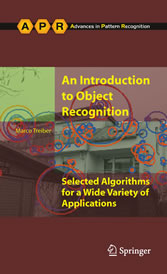Search and Find
Service
More of the content

An Introduction to Object Recognition - Selected Algorithms for a Wide Variety of Applications
Preface
6
Acknowledgments
9
Contents
10
Abbreviations
14
1 Introduction
15
1.1 Overview
15
1.2 Areas of Application
17
1.3 Requirements and Constraints
18
1.4 Categorization of Recognition Methods
21
References
24
2 Global Methods
25
2.1 2D Correlation
25
2.1.1 Basic Approach
25
2.1.1.1 Main Idea
25
2.1.1.2 Example
27
2.1.1.3 Pseudocode
28
2.1.1.4 Rating
28
2.1.2 Variants
29
2.1.2.1 Variant 1: Preprocessing
29
2.1.2.2 Variant 2: Subsampling/Image Pyramids
31
2.1.3 Phase-Only Correlation (POC)
32
2.1.3.1 Example
33
2.1.3.2 Pseudocode
34
2.1.4 Shape-Based Matching
34
2.1.4.1 Main Idea
34
2.1.4.2 Example
35
2.1.4.3 Pseudocode
35
2.1.4.4 Rating
36
2.1.5 Comparison
36
2.2 Global Feature Vectors
38
2.2.1 Main Idea
38
2.2.2 Classification
38
2.2.3 Rating
39
2.2.4 Moments
39
2.2.4.1 Main Idea
39
2.2.4.2 Example
40
2.2.5 Fourier Descriptors
41
2.2.5.1 Main Idea
41
2.2.5.2 Example
41
2.2.5.3 Modifications
43
2.2.5.4 Pseudocode
44
2.3 Principal Component Analysis (PCA)
45
2.3.1 Main Idea
45
2.3.2 Pseudocode
48
2.3.3 Rating
49
2.3.4 Example
49
2.3.5 Modifications
51
References
52
3 Transformation-Search Based Methods
54
3.1 Overview
54
3.2 Transformation Classes
55
3.3 Generalized Hough Transform
57
3.3.1 Main Idea
57
3.3.2 Training Phase
57
3.3.3 Recognition Phase
58
3.3.4 Pseudocode
59
3.3.5 Example
60
3.3.6 Rating
62
3.3.7 Modifications
63
3.4 The Hausdorff Distance
64
3.4.1 Basic Approach
64
3.4.1.1 Main Idea
64
3.4.1.2 Recognition Phase
65
3.4.1.3 Pseudocode
68
3.4.1.4 Example
70
3.4.1.5 Rating
71
3.4.2 Variants
72
3.4.2.1 Variant 1: Generalized Hausdorff Distance Generalized Hausdorff distance
72
3.4.2.2 Variant 2: 3D Hausdorff Distance
72
3.4.2.3 Variant 3: Chamfer Matching
73
3.5 Speedup by Rectangular Filters and Integral Images
73
3.5.1 Main Idea
73
3.5.2 Filters and Integral Images
74
3.5.3 Classification
76
3.5.4 Pseudocode
78
3.5.5 Example
79
3.5.6 Rating
80
References
80
4 Geometric Correspondence-Based Approaches
82
4.1 Overview
82
4.2 Feature Types and Their Detection
83
4.2.1 Geometric Primitives
84
4.2.1.1 Polygonal Approximation
84
4.2.1.2 Approximation with Line Segments and Circular Arcs
84
4.2.2 Geometric Filters
87
4.3 Graph-Based Matching
88
4.3.1 Geometrical Graph Match
88
4.3.1.1 Main Idea
88
4.3.1.2 Recognition Phase
89
4.3.1.3 Pseudocode
91
4.3.1.4 Example
92
4.3.1.5 Rating
92
4.3.2 Interpretation Trees
93
4.3.2.1 Main Idea
93
4.3.2.2 Recognition Phase
94
4.3.2.3 Pseudocode
97
4.3.2.4 Example
98
4.3.2.5 Rating
99
4.4 Geometric Hashing
100
4.4.1 Main Idea
100
4.4.2 Speedup by Pre-processing
101
4.4.3 Recognition Phase
102
4.4.4 Pseudocode
103
4.4.5 Rating
104
4.4.6 Modifications
104
References
105
5 Three-Dimensional Object Recognition
107
5.1 Overview
107
5.2 The SCERPO System: Perceptual Grouping
109
5.2.1 Main Idea
109
5.2.2 Recognition Phase
110
5.2.3 Example
111
5.2.4 Pseudocode
111
5.2.5 Rating
112
5.3 Relational Indexing
113
5.3.1 Main Idea
113
5.3.2 Teaching Phase
114
5.3.3 Recognition Phase
116
5.3.4 Pseudocode
117
5.3.5 Example
118
5.3.6 Rating
120
5.4 LEWIS: 3D Recognition of Planar Objects
120
5.4.1 Main Idea
120
5.4.2 Invariants
121
5.4.3 Teaching Phase
123
5.4.4 Recognition Phase
124
5.4.5 Pseudocode
125
5.4.6 Example
126
5.4.7 Rating
127
References
128
6 Flexible Shape Matching
129
6.1 Overview
129
6.2 Active Contour Models/Snakes
130
6.2.1 Standard Snake
130
6.2.1.1 Main Idea
130
6.2.1.2 Optimization
131
6.2.1.3 Example
132
6.2.1.4 Rating
133
6.2.2 Gradient Vector Flow Snake
134
6.2.2.1 Main Idea
134
6.2.2.2 Pseudocode
135
6.2.2.3 Example
136
6.2.2.4 Rating
137
6.3 The Contracting Curve Density Algorithm (CCD)
138
6.3.1 Main Idea
138
6.3.2 Optimization
140
6.3.3 Example
141
6.3.4 Pseudocode
142
6.3.5 Rating
142
6.4 Distance Measures for Curves
143
6.4.1 Turning Functions
143
6.4.1.1 Main Idea
143
6.4.1.2 Example
145
6.4.1.3 Pseudocode
146
6.4.1.4 Rating
147
6.4.2 Curvature Scale Space (CSS)
147
6.4.2.1 Main Idea
147
6.4.2.2 Pseudocode
150
6.4.2.3 Rating
151
6.4.3 Partitioning into Tokens
151
6.4.3.1 Main Idea
151
6.4.3.2 Example
153
6.4.3.3 Pseudocode
154
6.4.3.4 Rating
155
References
155
7 Interest Point Detection and Region Descriptors
156
7.1 Overview
156
7.2 Scale Invariant Feature Transform (SIFT)
158
7.2.1 SIFT Interest Point Detector: The DoG Detector
158
7.2.1.1 Main Idea
158
7.2.1.2 Example
159
7.2.2 SIFT Region Descriptor
160
7.2.2.1 Main Idea
160
7.2.2.2 Example
161
7.2.3 Object Recognition with SIFT
161
7.2.3.1 Training Phase
161
7.2.3.2 Recognition Phase
161
7.2.3.3 Pseudocode
163
7.2.3.4 Example
164
7.2.3.5 Rating
165
7.2.3.6 Modifications
166
7.3 Variants of Interest Point Detectors
166
7.3.1 Harris and Hessian-Based Detectors
167
7.3.1.1 Rating
168
7.3.2 The FAST Detector for Corners
168
7.3.2.1 Rating
169
7.3.3 Maximally Stable Extremal Regions (MSER)
169
7.3.3.1 Rating
170
7.3.4 Comparison of the Detectors
170
7.4 Variants of Region Descriptors
171
7.4.1 Variants of the SIFT Descriptor
171
7.4.2 Differential-Based Filters
173
7.4.3 Moment Invariants
174
7.4.4 Rating of the Descriptors
175
7.5 Descriptors Based on Local Shape Information
175
7.5.1 Shape Contexts
175
7.5.1.1 Main Idea
175
7.5.1.2 Recognition Phase
176
7.5.1.3 Pseudocode
178
7.5.1.4 Rating
179
7.5.2 Variants
179
7.5.2.1 Labeled Distance Sets
179
7.5.2.2 Shape Similarity Based on Contour Parts
180
7.6 Image Categorization
181
7.6.1 Appearance-Based ''Bag-of-Features'' Approach
181
7.6.1.1 Main Idea
181
7.6.1.2 Example
182
7.6.1.3 Modifications
183
7.6.1.4 Spatial Pyramid Matching
184
7.6.2 Categorization with Contour Information
185
7.6.2.1 Main Idea
186
7.6.2.2 Training Phase
187
7.6.2.3 Recognition Phase
189
7.6.2.4 Example
189
7.6.2.5 Pseudocode
190
7.6.2.6 Rating
191
References
192
8 Summary
194
Appendix A Edge Detection
198
A.1 Gradient Calculation
199
A.2 Canny Edge Detector
200
References
202
Appendix B Classification
203
B.1 Nearest-Neighbor Classification
203
B.2 Mahalanobis Distance
204
B.3 Linear Classification
205
B.4 Bayesian Classification
206
B.5 Other Schemes
206
References
207
Index
208
All prices incl. VAT












